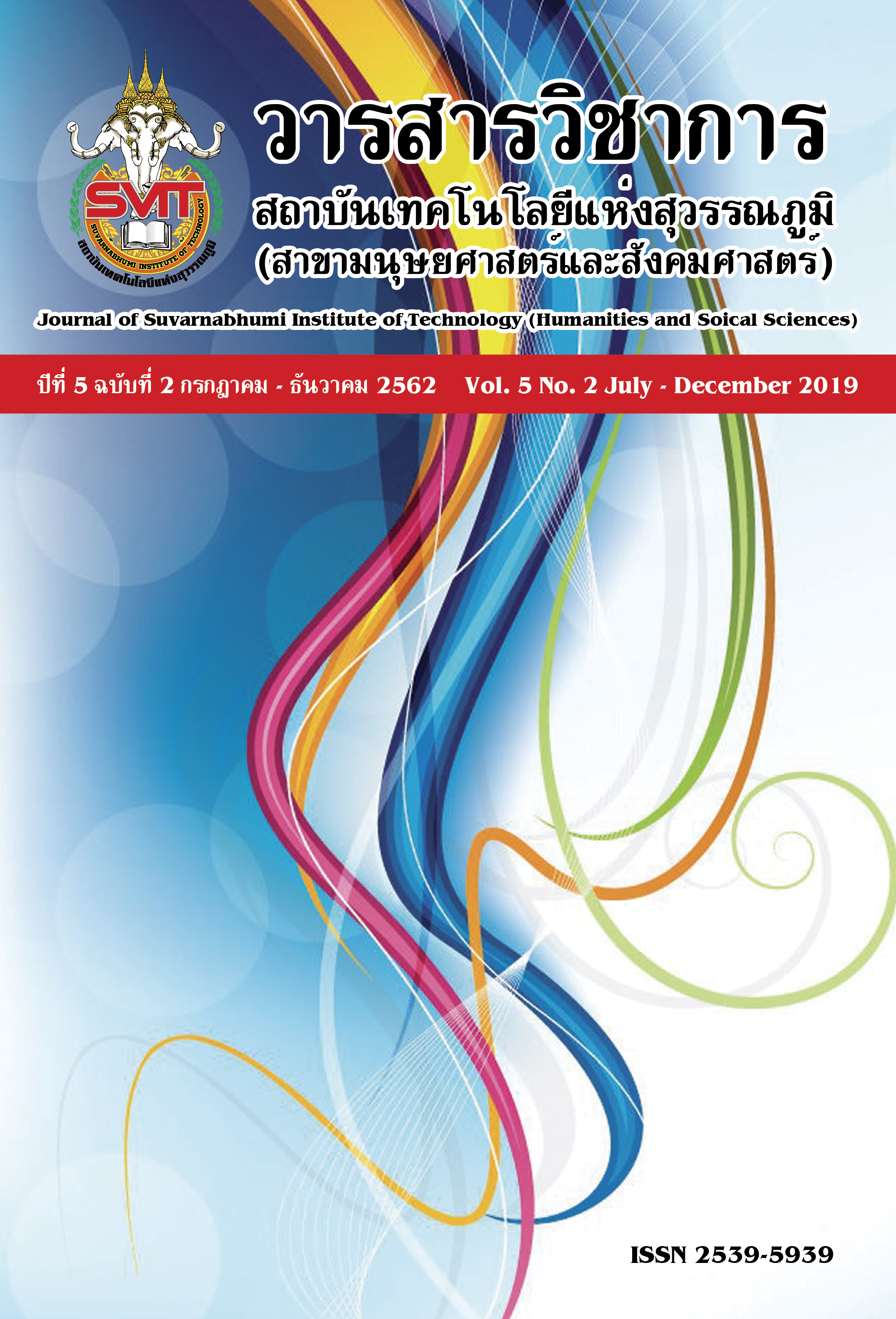THE QUALITY OF WORK LIFE’S RELATED TO THE PERFOREMANCE OF CUSTOMER SERVICE EMPLOYEE IN COMMERCIAL BANK
Keywords:
enhance quality of work life, work performance, customer service employeeAbstract
This research aim to : 1) study the quality of work life of customer service employee in commercial bank. 2) study the performance of customer service employee in commercial bank. 3) study the quality of work life related to the performance of customer service employee in commercial bank. 4) provide a guideline for enhancing the quality of work life in relationship to performance of customer service employee in commercial bank. The sample of 12 interviewees in qualitative research and 385 of customer service employees of commercial banks in quantitative research approach. The research instruments were questionnaire and interview form. Statistic used in quantitative data analysis as Percentage, Mean, Standard Deviation and Pearson Product Moment Correlation Coefficient. For qualitative data analysis used the content analysis method.
The result of this research showed that:-
1.The quantitative research showed that the quality of work life of customer service employee of commercial bank overall was at the highest level. When considering each aspect, it was found that the aspect with the highest mean as the first is quality of life interm of work that is beneficial to society. The last mean as the working condition which is safe and healthy. The results of the analysis of the performance of customer service employee of commercial bank it was found that overall was the highest level. When considering in each aspect found that the aspect with the highest everage first is the quality of work. The last mean average is the expenditure. The results of the analysis of relationship between work efficiency and quality of work life found that there is a relationship in the same direction and the result of the quality of working life and work efficiency of employees found that there are statistically significant difference at the level .05.
- Qualitative research results showed that the efficiency of the work that interviews executive management level of commercial banks and academics has the opinion that the efficiency in quality of work must be in same direction the employee must work in a way that does not cause mistakes in the work. The workload efficiency must be in the same direction in accordance with the target and employee must be able to handle the workload increase and maintain the standard performance. The time efficiency employees must be able to perform their work within the standard time which determined by organization. The cost efficiency, employees must spend less but work well without damage the organization. The quality of work life of the customer service employee relative to the efficiency of work. It was found that the executive management and academics had opinion in each of the following areas. The compensation must be appropriate and fair to enable employees to work in a potent, safe and healthy promotion as standardized. To provide opportunities for potential development of personnel, promote progress and stability in the work as well as having a social relationship, promoting democracy in the organization, balance between personal life and work, and social work. The conclusion is that executive management and academics pay more attention to the efficiency of compensation is sufficient and fair as first. Secondary, safety is the most secure and the last is stability and progression in work.
References
เจนจิราพร รอนไพริน. (2558). ความพึงพอใจในการปฏิบัติงานของพนักงานธนาคารกรุงไทย จำกัด (มหาชน). สาขาอรัญประเทศ จังหวัดสระแก้ว. วิทยานิพนธ์มหาบัณฑิต, มหาวิทยาลัยบูรพา.
ชยาภรณ์ แสงเฟื่อง. (2560). อิทธิพลของผลตอบแทนขององค์การต่อพฤติกรรมการเป็นสมาชิกที่ดีขององค์การ ความผูกพันกับองค์การและผลการปฏิบัติงานของพนักงานธนาคารไทยพาณิชย์. ดุษฎีนิพนธ์บริหารธุรกิจดุษฎีบัณฑิต, มหาวิทยาลัยรามคำแหง.
ตรีเนตร ตันตระกูล. (2558). การพัฒนาทรัพยากรบุคคลในสำนักงานเขตประเวศ กรุงเทพมหานคร. [ออนไลน์]. แหล่งที่มา http://journal.svit.ac.th/index.php/1/article/view/20 [12 พฤษภาคม 2561].
ทศพร ทรงเกียรติ. (2554). แรงจูงใจที่มีผลต่อประสิทธิภาพการทำงานด้านภูมิสารสนเทศของพนักงานการไฟฟ้าส่วนภูมิภาค เขต 3 (ภาคเหนือ). การค้นคว้าอิสระ บริหารธุรกิจมหาบัณฑิต, มหาวิทยาลัยเทคโนโลยีราชมงคลธัญบุรี.
ธนาคารกสิกรไทย. (2558). รอบรู้ธุรกิจ. [ออนไลน์]. แหล่งที่มา https://www.kasikornbank.com [12 พฤษภาคม 2561].
ธนาคารกสิกรไทย. (2560). รายงานการพัฒนาเพื่อความยั่งยืน, [ออนไลน์]. แหล่งที่มา https://www.kasikornbank.com/th/social-Activities/Pages/CSRAnnuval Reports.aspx. [10 พฤษภาคม 2561].
นวพร เรืองสกุล , ปิยนาถ บุนนาค และคนอื่น ๆ. (2550). 100 ปี จากบุคคลัภย์สู่ไทยพาณิชย์. กรุงเทพมหานคร: ธนาคารไทยพาณิชย์.
แบงค์ลดสาขา เน้นคนไอทีรับยุคดิจิทัล. (2559, สิงหาคม 8). กรุงเทพธุรกิจ, หน้า 4.
พจน์ พจนพาณิชยกุล. (2556). การพัฒนาประสิทธิภาพในการทำงานของบุคคล. [ออนไลน์]. แหล่งที่มา https://sites.google.com/site/potarticle/. [25 พฤษภาคม 2561].
วิภาวรรณ เอ่งฉ้วน. (2556). ปัจจัยที่มีผลต่อแรงจูงใจในการปฏิบัติงานของพนักงานธนาคารออมสิน ในสังกัดธนาคารออมสิน เขตกระบี่. วิทยานิพนธ์ปริญญาบริหารธุรกิจมหาบัณฑิต กลุ่มวิชาการจัดการคณะบริหารธุรกิจ, มหาวิทยาลัยหอการค้าไทย.
เสกสรร อรกุล. (2557). ปัจจัยแรงจูงใจในการปฏิบัติงานที่มีผลต่อประสิทธิภาพในการทำงานของพนักงาน บริษัท เมทเทิลคอม จำกัด. วิทยานิพนธ์ปริญญามหาบัณฑิต , มหาวิทยาลัยศรีปทุม.
อารีรัตน์ ปานศุภวัชร. (2560). ความสัมพันธ์ระหว่างความสามารถในการบริการกับประสิทธิภาพการทำงานของผู้บริหารแผนกต้อนรับส่วนหน้าธุรกิจโรงแรมภาคตะวันออกเฉียงเหนือ. รายงานการวิจัยคณะบัญชีและการจัดการ, มหาวิทยาลัยมหาสารคาม.
Becker,S.W. & Neuhauser, D. (1975). The Efficient Organization. New York: Elsevier Scientific Publishing Co., Ltd.
Bluestone, Irving. (1977). Implementating Quality of worklife Programs. Management Review, 6(9) p.p. 43-46.
Certo, Samuel C. (2000). Modern Management. New York: Prentice – Hall.
Cochran, W.G. (1977). Sampling Techniques. (2nd ed.). New York : John Wiley and Son, Inc.
Cronbach Lee Joseph. (1974). Essentials of Psychological Testing. (3rd ed.). New York: Harper and Row.
Davis, K. (1977). Human behavior at work. New York: McGraw – Hill.
Deming, W. E., J. Orsini and D. D. Cahill. (2012). The Essential Deming: Leadership Principles from the Father of Quality. New York : McGraw-Hill.
Daniel, J. J., & Sanz Valle, R. (2008). Could HRM support organizational innovation. International Journal of Human Resource Management.
Dessler, G. (2000). Human Resource Management (8th ed.). New Jersey: Prentice-Hall.
Huse, E.F., and Cummings, T.G. (1985). Organizational Development and Change. St. Paul, Minn : West.
Nielsen, T. M., Hrivnak, G. A., & Shaw, M. (2009). Organizational citizenship behavior and performance: A meta-analysis of group-level research. Small Group Research.
Peterson, Emore, and E. Grovenor Plowman. (1953). Business organization and management – home wood. Illinoise: Richard D. Irwin.
Puathui, C. (2010). A study of happiness levels in the work of nurses: A case study of Siriraj Hospital. Master Independent Study, Silpakorn University.
Royuela Moreno, Vaya. (2007). The institutional V.S. the academic definition of the quality of work Life : What is the focus of the European Commission? Springer, 401-415.
Simon, Herbert A. (1960). Administrative Behavior. New York : The McMillen Company.
Walton. (1975). Criteria for Quality of Working Life. In Loues E.Davis and Albert B. Cherns (eds.). The Quality of Working Life. New York : Free Press.
Downloads
Published
Issue
Section
License
บทความที่ได้รับการตีพิมพ์เป็นลิขสิทธิ์ของวารสารวิชาการ สถาบันเทคโนโลยีแห่งสุวรรณภูมิ
ข้อความที่ปรากฏในบทความแต่ละเรื่องในวารสารวิชาการเล่มนี้เป็นความคิดเห็นส่วนตัวของผู้เขียนแต่ละท่านไม่เกี่ยวข้องกับสถาบันเทคโนโลยีแห่งสุวรรณภูมิ และคณาจารย์ท่านอื่นๆในสถาบันฯ แต่อย่างใด ความรับผิดชอบองค์ประกอบทั้งหมดของบทความแต่ละเรื่องเป็นของผู้เขียนแต่ละท่าน หากมีความผิดพลาดใดๆ ผู้เขียนแต่ละท่านจะรับผิดชอบบทความของตนเองแต่ผู้เดียว





